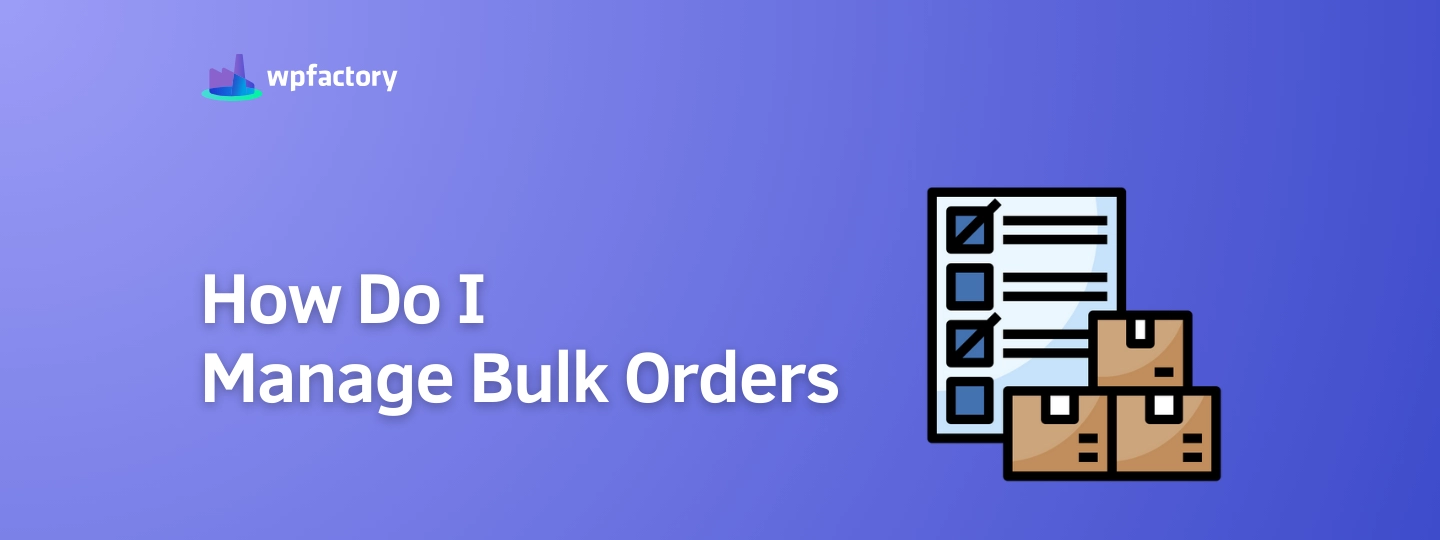Managing Bulk Orders: Pricing, Acceptance & Fulfillment Strategies
Proper management of bulk orders is essential as they’re a bit tricky to deal with. Unlike usual orders, there are additional overheads to bulk sales orders, such as handling shipment and bulk discounts.
Bulk orders are the type of orders where customers purchase a large quantity of units after being incentivized by a large discount. These orders often require special attention to inventory management and shipping logistics.
In this article, we will introduce in detail what bulk orders are, how to manage them properly, and recommend tools and strategies that can be a great asset for managing these types of orders. Effective bulk order management can enhance operational efficiency and boost customer satisfaction.
Understanding Bulk Orders
Bulk orders are purchases of a large quantity of a single item or a set of items by a single customer, they’re usually accompanied with a discounted rate as an incentive.
Bulk orders are common in: B2B, wholesale, and special promotions. In B2B, businesses usually buy large quantities of the same product from manufacturers and rebrand them using their own brand name. These sellers could be manufacturers, wholesale retailers or distributors. Regular retail stores can also sell in bulk, such that customers can take advantage of discounts during sales events.
It’s crucial to understand the ins and outs of bulk orders, and how to manage the entire process end to end to ensure a successful order fulfillment and a happy customer.
Challenges of Managing Bulk Orders
The process of managing an order, as we view it, starts from planning the pricing of your product, through receiving a customer order until the order is delivered to customer.
If done right, it can improve order accuracy, preserve customer’s loyalty, and give your business a competitive edge.
Managing sales orders is a significant process that a lot of e-commerce businesses have to deal with effectively and correctly, bulk orders are no exception. Customers demand low prices, personalized services, and reliable delivery promises. Given the ongoing cost increase of labor, inventory, and transportation, the job is becoming no easier than ever at all. In fact, it is stretching retailers’ margins thinner than ever. In addition to the need to adapt and quickly react to constant surprises and disruptions, from product and labor shortages to blocked shipping lanes.
Let us discuss here some of the common pitfalls and challenges in managing bulk orders:
1. Inventory Management
Challenge:
A common challenge in inventory management is the risk of stockouts and overstocking. Stockouts occur when a customer orders a large quantity that your stock is not ready for, leading to unfulfilled orders and unhappy customers. Conversely, overstocking happens when you hold too much inventory, resulting in budget constraints due to storage and handling costs.
2. Pricing Strategy
Challenge:
Implementing effective pricing strategies to incentivize bulk orders can be challenging. While various strategies exist, choosing the right one and successfully implementing it requires careful planning and execution.
Solution:
To maximize sales and incentivize bulk orders, businesses can implement various pricing strategies. One effective approach is to establish a tiered pricing structure, offering discounts based on the quantity of items purchased. This encourages customers to buy in bulk while ensuring sustainability for the business. Here is a brief of some of these strategies:
Quantity Discount
In this paradigm, as customers buy more, discounts escalate. It leverages the psychology of savings and encourage customer to go bulk. It benefits customers greatly as they opt for larger orders, they get significantly more discounts. At the same time, large order sizes lead to increased revenue, contributing greatly to your business growth.
You’ve to consider profit margin when implementing this model as you need to assess if your profit margin remains healthy with these ongoing discounts. Do your math and analysis before you implement this strategy and make sure that it is beneficial for both of you and your customers. Also, leverage this strategy to strengthen relationship with your customers by setting tiered discounts.
Threshold Discounts
The main gist of this model is that a specific percentage discount is applied based on a particular range of units purchased in a tiered system. For example:
- 2 – 20: You get full price discount (one item free).
- 20 – 50: 10% discount
- 50 – 100: 20% discount
- 100 – 200: 40% discount
As you can see, it is very similar to quantity discount that we discovered earlier, however, it is based on tiers, the more you buy, you unlock a new tier discount.
Package Discounts
When customers go to the store, they sometimes purchase a set of specific items together, for example, if they buy a notebook, they may also need a pen, pencil, an eraser, and maybe a ruler. Well, how about offering a discount when you buy all these things in one package.You may often encounter this type of discount on Amazon. If you add to cart an item such as earbuds, it suggest you to buy together, the earbuds, phone casing, and earbuds casing at a discounted price rather than buying all items individually at a higher price.
The pricing strategy is very similar to threshold discount or tiered discount, your store should offer a discount for a certain number of units, and it should increase as the number of units increases in certain predefined step sizes.
Free Shipping
So, you’ve done the math and figured that you can’t really afford running these fancy discounts we discussed earlier. Well, you can still one more thing. One of the best ways to make your customers happy is free shipping! Offer your customers free shipping when they purchase units at a number beyond a specific threshold. For example, if cart has more than 10 items of a specific unit, you can offer free shipping on this order!Keep in mind that you don’t have to restrict yourself to these methods to implement your discount strategy! You can tweak and cater them depending on your needs and your business model.
Additionally, consider leveraging dynamic pricing tools like the Dynamic Pricing & Bulk Quantity Discounts Plugin. This tool enables you to set tiered pricing and volume discounts effortlessly, ensuring competitiveness in the market while maximizing profitability. By utilizing such tools alongside these pricing strategies, businesses can effectively incentivize bulk orders, drive sales, and enhance customer satisfaction.
Bulk Discounts Matters! Here’s Why
- Increased Sales: The more your customers buy, the more they get discounts which enhances significantly your sales that in turn increases your revenue.
- Customer Loyalty: Customers who buy in bulk are most likely to return again to purchase another bulk due to the discounts hence they will remain loyal to your brand. This is where bulk discount becomes an extremely powerful strategy to retain your existing customers.
- Cost Optimization: When you sell large quantity of items consistently, your heavily reduce your inventory, and thus optimizing their cost as you will reduce the need for excessive storage space and handling costs. In addition to shipping costs per unit decrease when shipping larger number of units together which also reduces transportation expenses. You’re also reducing marketing costs along the way, since bulk purchases lead to repeat business and a loyal customer.
3. Order Processing
Challenge:
As the size of the order increases, the risk of errors and delays also rises. Large orders may overwhelm existing processes, leading to inefficiencies and potential errors in order fulfillment. This can result in delayed delivery times and dissatisfied customers.
Solution:
To address the challenge of managing large orders efficiently, businesses can implement the following strategies:
- Streamlined Workflow: Develop a streamlined workflow specifically designed to handle large orders. This may involve reorganizing the order processing system, assigning dedicated resources, and establishing clear protocols for handling bulk orders.
- Automation: Implement automation tools and technologies to streamline order processing tasks. Automation can help reduce manual errors, improve accuracy, and expedite the fulfillment process for large orders.
- Scalable Infrastructure: Invest in scalable infrastructure and resources that can accommodate fluctuations in order volume. This may include upgrading software systems, expanding warehouse capacity, and optimizing logistical operations to handle increased demand effectively.
4. Customer Communication
Challenge:
Imagine you placed an order online and you didn’t manage neither an email confirmation nor even a text message to confirm your order, how would you feel? It is not a very pleasant experience indeed! It could lead to customers duplicating their orders and things become a mess because you haven’t sent your customer a confirmation that you have received
their order.
Solution:
Implementing an automated system to promptly send confirmation emails or text messages upon order placement ensures that customers receive immediate acknowledgment of their purchases. Additionally, utilizing the Email Verification for WooCommerce Plugin authenticates customer accounts, preventing spam and ensuring genuine interactions. Leveraging the plugin’s capabilities further, personalized emails tailored to individual customers can include updates on order status, delivery information, and promotional offers.
5. Storage and Logistics
Challenge:
If you don’t have enough space for your inventories, where should they go? You have to carefully plan ahead all your inventory along with your storage capacity. Additionally, coordinating the packaging and shipping of large orders efficiently can be complex and challenging.
Solution:
Third-Party Logistics (3PL): eCommerce stores can partner with third-party logistics providers to handle overflow inventory and manage shipping logistics. 3PL providers offer additional storage space and expertise in managing large orders efficiently and cost-effectively.
Warehouse Management System (WMS): Implementing a robust warehouse management system helps eCommerce stores track inventory levels, manage stock locations, and streamline order picking processes. This ensures efficient use of storage space and accurate inventory management.
6. Payment Handling
Challenge:
Bulk orders involve large purchases, leading to substantial payments. These transactions must be prioritized for security and efficiency to prevent fraudulent activities that can result in significant losses.
Solution:
Enhance security by implementing SSL encryption and two-factor authentication and using fraud detection tools to monitor transactions in real-time. Utilize the Payment Gateways per Product for WooCommerce Plugin to manage payment options for specific products, adding an extra layer of control and security. Establish a dedicated team or automated system for swift and secure processing of bulk order payments. This approach minimizes the risk of errors and delays, ensuring smooth and safe financial operations for eCommerce stores.
Conclusion
Efficient bulk order management is critical for eCommerce success. By utilizing dynamic pricing and automation tools, optimizing workflows, and ensuring strong communication and payment security, businesses can streamline operations, improve customer satisfaction, and boost profitability.
In summary, mastering bulk order management provides eCommerce stores with a competitive advantage, enabling them to meet customer needs, reduce costs, and maximize profits. With the right tools and strategies in place, handling bulk orders can become a seamless and rewarding aspect of your business operations.









